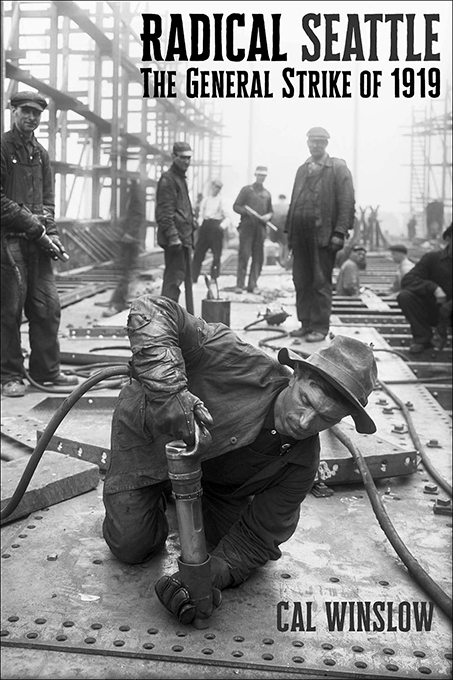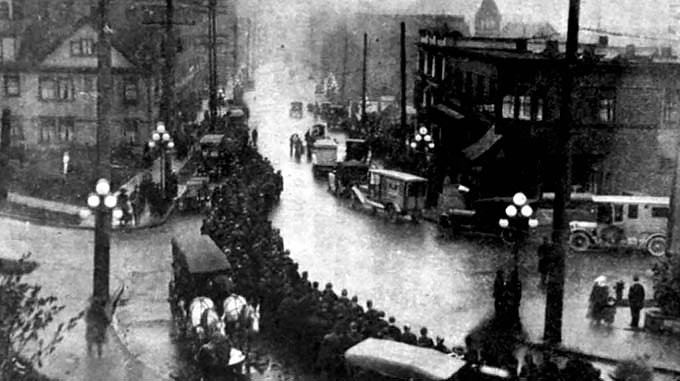Not a Simple Story
By Peter Olney

“Radical Seattle The General Strike of 1919” by Cal Winslow Monthly Review Press 2020
In December of 1997 I was hired by the International Longshore and Warehouse Union (ILWU) to become their first Director of Organizing. At its International Convention in Hawaii in June of that same year the union had decided to dedicate 30% of its revenue to organizing and build out a department. I was honored to get the assignment of directing the union’s regional organizing staff. My first task was to head up to the Puget Sound to investigate the feasibility of organizing workers in the Duwamish River, a container and barge staging area for the Alaska trade. At the time the Inland Boatmen’s Union of the Pacific (IBU), the ILWU’s marine division owned a small launch for their patrolmen to use in policing their tug, barge and ferry jurisdiction in the region. ILWU elected leaders and organizers clambered onto the launch for the short ride to West Seattle to eat at “ Salty’s on Alki“ a famous seafood restaurant for a working lunch. When we got to the dock in West Seattle, I stepped off the launch, lost my footing and fell halfway into the drink. Great start for an Organizing Director! I loudly proclaimed, “I hope I know more about organizing than I do about maritime.” That was my frigid introduction to Elliot Bay and Seattle.
Cal Winslow’s important book, “Radical Seattle” reintroduces me to the region through the lens of the history of one of labor’s great moments, the Seattle General Strike of 1919. While the actual strike was of short duration and questionable results, the events leading up to it and its subsequent impact on labor and the region are important for any serious labor practitioner to understand. Moreover, in light of the pandemic and the Black Lives Matter risings, it becomes even more important to understand the factors that give rise to mass labor actions and to general strikes of which there have been few in our nation’s history. Strike talk is often in the air when crises arise, but often those yelling the loudest for a general strike have the least understanding of the factors and organizing involved in pulling one off. Winslow’s work gives us a valuable panorama of the complicated factors that led to the Seattle action on the heels of WW I.
As my friend and astute student of labor risings, Katy Fox Hodess from Sheffield University, has taught me, worker risings and worker power get exercised in the context of social and political support: “We have to be careful when we talk about logistics workers and the potential power that’s there because of their position in the economy. There are so many other contextual factors that are shaping the possibilities for logistics workers to organize. Some of those factors — particularly the role of the state — are difficult to overcome. And it’s even more difficult in other parts of the world. It is one thing to have potential power in the workplace; it is another to have the confidence and support to exercise it.”[1]
There is a legacy of the Seattle General Strike that permeates the labor movement in Seattle to this day. The ILWU locals in the Puget Sound region have been and remain some of the most progressive in the union. The IBU has been a starter engine for the whole union in motivating support for progressive causes and for the recent candidacies of Bernie Sanders for President. Post retirement from the ILWU I have been doing training and teaching at the Building Trades Academy of the North American Building Trades Unions (NABTU). Consistently our student organizers from the Seattle area are often the most forward thinking in their practices and the most embracing of change in their ranks. The Cement Masons have the largest cohort of women members of any cement local in the country. The King County (Seattle) Labor Council recently expelled the Seattle Police union from their ranks after the murder of George Floyd in Minneapolis. There is something in the air in Seattle and its environs. Winslow’s book peels back the history of why the region is the way it is. Winslow is eminently qualified to tell this story as a native son of south Seattle and the Holly Park housing projects. His parents were both active in the worker’s movement, so he grew up around the Labor Temple and learned early on that a picket line meant, “Do not Cross!”.
Just as San Francisco grew dramatically because of the Gold Rush and the Pacific trade, Seattle and the Puget Sound region grew because it is two days closer to Russia and Asia by sea than San Francisco, and it is the portal to the Alaska gold rush and the shipment of extractive industries like mining and lumber. These are the objective conditions that give rise to vital maritime industries of shipbuilding and cargo transport. And on that terrain there are many battles leading up to the 1919 general strike. In his first chapter, The Union’s Inspiration, Winslow challenges himself to deliver an understanding beyond these objective conditions and work relations: “The challenge is to expand our field of vision in time, stretching it both backwards and into the future, and geographically not contract it. We have to consider the roots of the strike, to follow the development of a movement, to see this historical moment in context”.[2]

The general strike was the culmination of a series of actions. The Everett Massacre of late 1916 shaped the consciousness of many and was a touchstone moment for the roll up to 1919. Cops and thugs murdered Industrial Workers of the World timber workers and supporters. In a subsequent trial in 1917 the framed up IWW members were exonerated and that victory resonated nationwide and brought energy and confidence to the Seattle conflict. The IWW was active in logging and lumber and other extractive industries and was a huge influence on the consciousness of western workers in particular.
But a broad array of political forces influenced the workers of Seattle and were the agitators for the general strike important among them the Socialist Party with Eugene Debs as its Presidential candidate had garnered 1 million votes in 1912.
What is perhaps most interesting about Winslow’s historical journey is that he captures the radicalism of craft unions that were the leading forces in this strike. This is of course prior to the massive industrial organizing drives of the CIO in the 30’s so most of American trade unionism was craft based aside from the needle trades and the mineworkers. But it also contradicts any analysis that condemns all craft unionism to be conservative and inherently backward. Here again conditions and conscious leadership play a major role in shaping action. In fact, 110 different AFL craft unions ended up supporting the five-day general strike, which was sparked by the strike of craft unions at shipyards in Elliot Bay. Further for those in today’s labor left who disdain the often-crusty and exclusive “Political Action Committee” role of central labor bodies, it is important to reflect on the fact that this general strike in February of 1919 was led by the Central Labor Council.
60,000 workers of all crafts went out for five days in support of a Metal Trades Council strike of 35,000 at the Seattle shipyards. And while the 60,000 went back to work on February 11, the shipyard workers remained out until March. It is not clear what was won and lost in this battle but the experience of the five-day paralysis of the wheels of commerce influences consciousness in the Seattle working class to this day.
After quoting his mentor, the great British Marxist historian EP Thompson, “Consciousness of class arises in the same way in different times and places, but never just the same way”[3], Winslow goes on to characterize the Seattle experience, “In Seattle, class consciousness arose in the utopian colonies, in logging camps and mills, in free speech fights, in Everett and on the waterfront. In war and in dissent, in strikes of the telephone girls, waitresses, hotel maids, “lady barbers”, and laundry workers, in co-ops and working-class neighborhoods”. This is a book that paints an overall picture of a complicated terrain within which political actors maneuver, building alliances, sometimes temporal, that result in big change and a lasting heritage. Big battles happen because of multiple factors and underlying history and conditions. “Radical Seattle” is a wonderful antidote to overly simple and linear strategies for labor. It is a blow to those who conceptualize labor history as the simple rising of rank and file radicals challenging the crusty bureaucracy of their labor organizations. The Seattle general strike and any subsequent battles of any significance are always a more complicated mix. Thank you to Cal Winslow for this dynamic portrait. Pick it up online from Monthly Review Press and give it a read.
[1] https://www.jacobinmag.com/2018/10/choke-points-logistics-industry-organizing-unions
[2] “Radical Seattle: The General Strike of 1919” Page 41
[3] The Making of the English Working Class, EP Thompson Vintage Books February 1966
…
In 1970 I accompanied my brother Don to south Seattle to interview a survivor of the Everett Massacre. He was 96 and still of sound mind, a practiced Wobbly soapbox speaker who had told the story many times. He aptly brought to life that period of labor solidarity and unrest in Seattle, a history that shapes the culture of Seattle today.